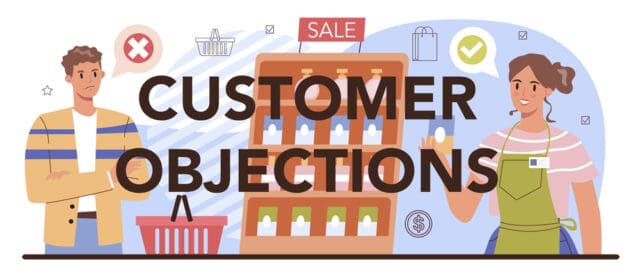Objection Handling: Master the 17 Best Techniques for Handling Sales Objection
Sales objections are common and should not be feared. Every prospect you speak with has a sales objection or a cause for not purchasing your goods.
You may uncover good-fit customers by addressing the appropriate sales qualification problems for all of your new leads and prospects when prospecting.
Why can’t you avoid sales objections? Because if the consumer had no doubts about the price, value, applicability to their circumstance, or purchasing capabilities of your product, they would have already purchased it.

While handling objections in sales is an inevitable aspect of the sales process, it may be a significant stumbling block for moving prospects through the funnel. Accepting the complaints and sending a breakup email right away may be tempting. This is particularly true if the problem looks pretty balanced, relying on what you realize about the prospect’s organization.
Sales reps must learn how to find and handle these common objections effectively. When a sales objection occurs, don’t give up; instead, re-emphasize the benefits of your product. This article will tell you everything you need to understand about overcoming sales objections, including how to reply to common ones.
What is the definition of objection handling?
When a prospect expresses a worry about a product or service that a salesperson is selling, the salesperson replies in a way that eases the prospect’s anxieties and allows the deal to proceed. The most common objections revolve around price, product fit, and competitors, and sometimes all it takes is a simple old-fashioned brush-off to overcome an issue.
Objection management is known as addressing a buyer’s objections in a way that affects their opinion or helps ease their anxieties.
Some salespeople debate with prospects or try to persuade them to change their minds, but this isn’t proper objection handling. Prospects are usually more convinced of their stance than ever before; worse, salespeople may lose the rapport and trust they’ve developed.
Rather than telling your prospects that they’re wrong, help them come to their own opinions. If you can’t convince them, it’s a hint they’re not a suitable match.
It’s also critical to understand the difference between sales objections and brush-offs. Brush-offs are justifications, whereas criticisms are genuine. An objection statement can be “I can see value in the product, although I’m not convinced about purchasing it for such a reason,” but a brush-off can be “I don’t need to speak with you.” Brush-offs are significantly less severe than objections.
What is the significance of managing objections?

Allowing sales concerns to go unanswered until the end of the process is the most harmful thing you can do to a deal. The longer a buyer has an opinion, the stronger that view is likely to be – and the more difficult it will be to change it.
With this in mind, instead of avoiding objections, accept them. You can also discover them in advance by routinely asking questions like:
- “Do you have any reservations about X?”
- “Are there any potential stumbling barriers to your purchase?”
- “How certain are you that [product] will be a success, and why?”
- “You appear to be concerned about X. What are your thoughts on the subject?”
How to Deal with Sales Objections
When aiming to meet sales goals, it’s critical to reply effectively to your lead or prospect’s concerns. It is always better to avoid responding rashly and to show some empathy. This process of creating relationships with prospective customers at each stage of the buyer’s journey is known as lead nurturing. Listening to the concerns of your prospects will also help to deal with objections to an extent.
1. Make active listening a habit
First of all, make sure you utilize active listening skills to soak in what your prospect is communicating as they share their problems with you. Listen to comprehend rather than reply to your prospect’s arguments. Allow them room to express their worries and objections without being interrupted while speaking.
2. Revisit what you’ve heard
Repeat things you hear after your prospect has aired their concerns to verify that you are comprehending correctly. This will help you understand their ideas, but it will also make your prospects feel heard and respected, which is crucial for creating trust.
3. Identify and address your prospect’s issues
Continue to establish trust by empathizing with your prospects and confirming their point of view once you’ve proven you understand where they’re coming from. This does not imply that you must disparage your product or endorse a rival.
If you’re selling automation software, for instance, and your prospect is concerned about their capacity to integrate it into their complicated system, this is a good illustration.
“I understand how tough it might be to integrate new software,” you can say. Fortunately, we have a fantastic IT staff that has worked with similar businesses before and can handle a smooth transfer for you.”
With your reaction, you acknowledge that their issue is legitimate and provide a remedy to ease their anxieties.
4. Follow up with further inquiries
You want to do everything you can to keep the discussion flowing when you discover objectives. Trying to ask follow-up questions might be a subtle technique to keep your prospects engaged if you notice them drifting away. Statements that can be addressed with a basic “yes” or “no” should be avoided.
5. Make use of social proof
Sharing the tale of another client who had similar worries and went on to find success with your product, depending on the nature of your prospect’s issue, can be a beneficial strategy. If you’re selling to businesses, you may also give the necessary details about your prospect’s rivals and any successes they’ve had in dealing with similar objections.
6. Establish a definite time and date for a follow-up
If your prospect requests additional time to consider their alternatives, offer them the space or time they need. However, you don’t like to have them waiting. To prevent wasting time, set a specific date and time to check up very soon, and agree to respond to questions they may have as they think about it.
7. Be prepared for sales objections
Finally, anticipating sales objections is the most successful technique for dealing with them. If you’re ready for criticism, it’s rarer to get kicked out of your game.
When prospects raise concerns, having a set of impartial ideas to provide them might help keep sales going forward. Because you take the time to listen to the consumer and understand their reasoning rather than responding with a knee-jerk reaction, they’re more likely to listen to you if you have a remedy to give.
We also recommend that salespeople use role-playing to enhance their ability to address objections. Let’s look at the most typical sales objections because now you understand objection management, why it’s essential, and how to improve.
Dealing with objections will help you sell more effectively

The selling process is incomplete without objections. Some are valid grounds to dismiss the candidate, while others are merely an attempt to ignore you. However, suppose you’re aware of typical arguments and know how to respond to them. In that case, you’ll be able to tell the difference between prospects who can become excellent customers and those with whom you have to end things, allowing you to become a more effective salesperson.
Organize, Endure, and Convince to Conquer Sales Objections
The main reasons your prospects can’t or didn’t purchase your service or product are sales objections. This can be attributed to a variety of factors.
Perhaps your goods do not fit inside their budget. Some customers will inform you that they don’t require your service. Others may remark that they don’t have faith in your firm. These are only a handful of the most prevalent objections encountered by salesmen.
However, you can’t afford to lose a possible transaction so fast. It’s your role to redefine your potential customer perspective and train your staff on how to correctly handle sales obstacles. Fortunately, if you can discover your prospect’s sales objection, you’ll gain valuable information about the specific pain area you need to address. Exceptional salespeople view objections as a chance to fine-tune their proposal and focus on the aspects that will significantly affect the transaction.
If you tackle the objection correctly, you can nearly always solve your prospect’s worries. On the other hand, specific objections can be used by your sales staff as a lead qualifying technique. They enable you to sort out low-value leads early on and can aid in the development of trust with actual prospects.
This article will teach you how to overcome sales objections, particularly the most prevalent ones, such as:
Price

If price concerns are your primary concern, you may need to improve your lead qualification. Intelligent salespeople, on the other hand, understand that a budget does not have to be a deal killer.
Time
This objection will put your sales talents to the test, particularly over the phone. Your ability to manage relationships and converse is crucial.
Competition
If a lead is utilizing a competitor, It shows that they have an interest in your product. It’s now up to you to show why your product/service is superior.
Trust
Ensure you have a few testimonials available if you’re a start-up. Customers would like to see a successful track record. Your ability to empathize is equally vital.
Change
When a prospect is hesitant to move, utilize your sales pitch to demonstrate the benefits and underline the implications for their company.
Authority
Ensure you’re interacting with the decision-maker right away. Allowing someone else to present your sales pitch to the end buyer is not good.
Need
If the prospect believes they don’t require your product, it’s upon you to rephrase the discussion and persuade them otherwise if you still think you can help them.
How to prepare sales staff to handle objections to a sale
An objection is an irritating, unwelcome obstacle in practically every aspect. This scenario is opposed to sales.
An objection provides you with a valuable chance to learn about your potential buyer’s challenges, address their unique requirements, and strengthen your connection. A question or objection paints a clear understanding of the situation you need to solve.
Most salespeople repeatedly offer the same products to the same audiences. If you want to improve your efficiency and conversion rate, you’ll need to develop a strategy for dealing with sales objections and anticipating the unexpected.
Identifying and expecting objections
The worst strategy for dealing with sales objections is to just hope they don’t happen. You have no plans to deal with your lead’s objections when they arise (and they will). What’s the best you can do?
Have a strategy for any potential objections so you know precisely how to respond right away. A variety of circumstances influences sales objections.
If you have numerous participants on a discovery call, your success rate will most certainly suffer. When speaking with prospects, you must consider the various markets, product levels, pricing ranges, and decision-making abilities.
Making these specific arguments a part of your sales training program is one method to achieve this. There’s no need to overthink things; all you have to do is plan ahead of time. Here’s a quick technique to completely transform your objection handling in the days ahead.
Make a list of the most typical sales objections you see daily.
- Develop a strategy for debunking them.
- Examine missed chances in the past, as well as call transcripts and email messages.
- Prepare a shortlist—at the very least; you should have a list of 15-25 of the most typical sales objections your team encounters.
- Determine why you weren’t capable of overcoming that objection at the time and what you’d do best to improve.
- Create a script that any team member may utilize to overcome obstacles with a comprehensive and transparent sales approach.
When dealing with sales concerns, keep your cool
After being confronted with an objection, remain calm, take a deep breath, and double-check that you truly listened to your prospect. A confident dismissal might have a more significant impact on your prospect’s connection with you than you believe.
Successful salespeople take longer to respond to objections than they do during the ‘regular’ sections of the sales interaction. Instead of jumping to defend or attempting to impress the prospect with how great their product is, the best performers calm down and display a sense of calm in the face of difficulties.
Average performers seek to disrupt and overwhelm their prospects with a barrage of words per minute. Top performers don’t always speak more slowly; instead, they keep a steady tempo and convey confidence to their prospects.
How can you educate your employees to remain cool in a stressful situation?
Have your salespeople practice making cold calls to one another in the workplace as an excellent place to start. This will help them to be more confident while making cold calls. Plus, instead of a real-life prospect, they may practice overcoming obstacles from a co-worker.
Divide your sales staff into pairs, and have one person call while the other writes down helpful criticism for their colleague.
Boost your sales endurance
How many various ways can you express your product’s worth? Sales stamina is required to seal a transaction. This entails coming up with a never-ending list of ideas to assist you in marketing your goods to a buyer. It’s essential to keep in mind that rage or aggressiveness nearly never succeeds.
Build up your stamina, especially when the possibility is playing hard to get. You must remain calm and show empathy.
Regroup and attempt to pool everyone’s suggestions if your sales team has trouble coming up with more than a few approaches to market a product. Organize your sales staff into a group and ask them to write down product information and benefits until they run out of options.
Provide feedback to your team

Everyone benefits from feedback, and it’s critical to deliver it to your staff on a regular basis in order to help them develop and maintain their selling standards.
You may make a habit of checking in with your staff on a monthly basis now that you’ve produced a list of typical objections for them. Set up a plan with your team to overcome specific sales obstacles, but make sure you follow through to guarantee proper execution.
Inquire about the objections they faced throughout the last sales cycle and have them guide you through the results. Provide comments and add any new objections to your list. Change the wording in your responses to keep your staff focused on progress. This paperwork might serve as an excellent training handbook for your employees.
17 Most Common Sales Objections
1. “It’s too costly.”
Price concerns are the most typical sort of objection, and they might even come from those who are planning to buy. Be careful: if you start emphasizing pricing as a selling element, you’ll find yourself reduced to a transactional intermediary. Instead, return to the product’s worth.
Counter argument example: “I’d want to go through the characteristics of [product] and how they can help with the [prospect problem] you mentioned.”
2. “I don’t have any money.”
It’s possible that your prospect’s company isn’t large enough or profitable enough right now to purchase a product like yours. Follow their progress to discover how you may assist your prospects in getting to a point where your product or service would be a good fit for their company.
Counter argument example: “I see your point. Allow me to describe some of our other products and services that could be a better fit for your current growth and budget.”
3. “This year’s budget is completely depleted.”
Your prospect is informing you that they’re having cash flow problems, which is a version of the “no money” complaint.
If a major issue arises, it should be handled as quickly as feasible. You can schedule a follow-up call asking when the funding is expected to return and when they can discuss it.
Counter argument example: “Let’s set up a conversation to discuss when you expect your funds to return. When would you expect it to happen?”
4. “We already have a relationship with [Vendor X].”
Working with a competitor’s prospects is a benefit in disguise. They’ve already identified a problem and developed a solution; they’ve already completed most of the teaching you’d be accountable for. You can invest your time talking about your product, which is something you’d have to avoid with a prospect who hasn’t yet identified their problem.
Even if a prospect works with a rival company, it doesn’t necessarily imply that they’re satisfied with them. Examine the connection and pay particular attention to any problems that may be resolved with your product.
Counter argument example: “What made you decide on [vendor]? What has worked for you in the past? What’s not to appreciate about that? Allow me to describe how [product] is unique.”
5. “I know where I can acquire a cheaper version of your goods.”
Figure out what you’re up for in this situation by researching. Are you in a competitive scenario with a prospect who is pitting you against the competition to get a better deal? Is your potential customer under the impression that an identical but less expensive product will suffice?
If it’s the former, put out your most significant discount and stress the attributes that distinguish your goods. If they urge you to go lower, go away. Enjoy the benefits of the comparison in the second situation. Make a point of highlighting the differences and focusing on combined worth instead of price.
Counter argument example: “What are the key differences between [product] and your alternative option?” What brings you the most happiness and support?
6. “I’m satisfied with [Competitor X].”
What if your lead is content? The same method applies here: figure out why they think their connection with your competition is valuable and pinpoint areas where your product may improve.
Counter argument example: “Wow, that’s fantastic. What aspects of the product or connection make you the happiest? I’d like to understand more about you and compare you to me.”
7. “I lack the necessary permission to approve this purchase.”
There’s no issue. Request from your prospect the name of the correct individual to communicate with, and then pass your call to them.
Counter argument example: “Can you tell me who I should contact about this purchase?” “Could you possibly guide me to them?”
8. “We’re being sold out / shrunk”
It only happens occasionally, but there’s usually nothing you can do about it when it does. There may be no agreement if there is no more firm. Wrap off the engagement professionally so that if your prospect gets a new job, they’ll be more inclined to re-engage with you from a new firm.
Counter argument example: “Appreciate the time and for conversing with me about this product.”
9. “I’m not familiar with your firm”
This objection can be a request for information. Instead of giving an elevator pitch, offer a brief explanation of your value proposition.
Counter argument example: “We’re an ad sales firm that works with publications like yours to sell ad space. I’d like to discuss your revenue strategy and see if we can collaborate.”
10. “We’re doing fantastic in X.”
If this issue is raised, ask a few clarifying questions and undertake some more qualifying.
Counter argument example: “What progress has been accomplished thus far?”
11. “We don’t have that kind of business hardship.”
This complaint is frequently expressed as a dismissive remark or because prospects haven’t recognized that they’re having a problem yet. And while you may eventually realize they don’t require your service, don’t accept their argument at its value.
Counter argument example: “Interesting. What solutions do you have to deal with that aspect of your business right now?”
12. “I’m not sure what you’re selling.”
It’s a negative indicator if your prospects can’t understand your product. It may be time to exclude your prospects if your product is exceptionally difficult or highly specialized for their understanding.
But don’t quit right away. Inquire about the components of your product that the prospect is unsure about, and then try describing it in a new way. Bring in a specialist or product engineer to handle queries that are above your scope.
Counter argument example: “What aspects of the product are you perplexed by? I’d be happy to put you in touch with a customer success technician or a product engineer who can further explain how we can assist you.”
13. “I’ve heard [company’s] concerns about you.”
The strength of word-of-mouth recommendations may be both a benefit and a punishment. Rather than quickly defending your solution, business, or brand, which will just serve to legitimize the criticism, express gratitude for their comments. Then follow up with a value-added offer.
This allows you to develop trust and credibility with your potential clients. They’ll automatically acquire a favorable view of you once you’ve provided them with a great experience.
Counter argument example: “Thank you for sharing your thoughts with me. I’ll forward it to [appropriate department]. Would you like to hear some recommendations for increasing your average invoicing response times while we’re on the call?”
14. “Your offer is too confusing”
Determine whether your prospect is perplexed by certain aspects or whether the product is genuinely beyond their comprehension. If the latter is the situation, you may have to disqualify yourself. And assure your prospects that if they opt to buy, they’ll receive assistance from your customer support staff and that you’ll be available to address any implementation issues they may have.
Counter argument example: “What features perplex you the most? Remember that our customer care staff will be accessible 24 hours a day, seven days a week to assist with implementation.”
15. “You don’t comprehend my difficulties.” I require assistance with Y, not X.”
Making your prospects feel heard is critical. Restate your assessment of their circumstances, then agree with your prospect’s assessment and go from there. Rewording your prospect’s statements may clear up a lot of misconceptions and hurt sentiments.
Counter argument example: “I’m sorry!” Allow me to reiterate my knowledge of your difficulties, and please advise if there is anything I’m missing or misrepresenting.”
16. “Your product lacks X functionality, which we require.”
Consider recommending a complementary product to go along with your own. However, if that specific requirement is critical and your solution is unable to meet it, your prospect may not be a suitable match. It’s time to disqualify yourself and move on to a stronger match.
Counter argument example: “Have you looked into [conjoining or companion product]? It’s an excellent match and may be utilized to solve for Y alongside it.”
17. “Your product is incompatible with our existing [tools, configuration].”
If the buyer is set on their current solution, this issue might be a deal-breaker. However, your product may eventually replace or obsolete these tools. It’s possible to find a workaround. Ask some questions to find out.
Counter argument example: “What tools do you use right now? What role do those tools play in your [strategy]? What would you hope to accomplish with those items?”
Conclusion: Overcome Sales Objections
It isn’t impossible to overcome sales hurdles. Sales objections, on the other hand, are ways to learn further about your prospects and their pain points. The more you understand about a prospect, the simpler it will be to win their confidence and demonstrate that your product can benefit their company. You’ll be one step ahead of the game when it comes to dealing with typical sales objections if you have a plan to deal with them before a pitch.
Begin to see sales objections in a new light, seeing them as chances to:
- Ensure that your prospects are qualified and ideal for your product.
- Personalize any correspondence depending on their issues, experiences, and background.
- Create a long-term consumer connection through building rapport.
Don’t just concentrate on getting over the obstacle. Keep your cool, stick to your strategy, and don’t hesitate to pass on leads that aren’t an excellent fit for your product.
Subscribe to our Newsletter
Sign up to receive email updates on new product announcements, exclusive sales and marketing content, special offers on email validation plans, and more.
We send curated content as per your preference and do not indulge in spam!
What would you like to know about
We’re committed to your privacy. TuxMailer uses the information you provide to us to contact you about our relevant content, products, and services. You may unsubscribe from these communications at any time. For more information, check out our privacy policy.



